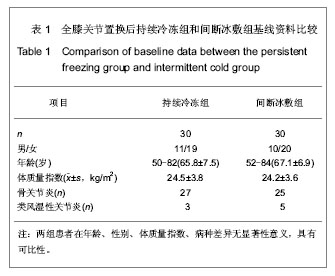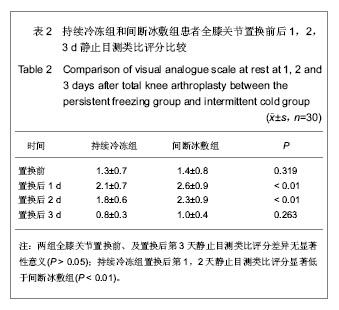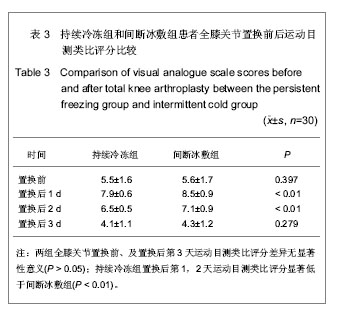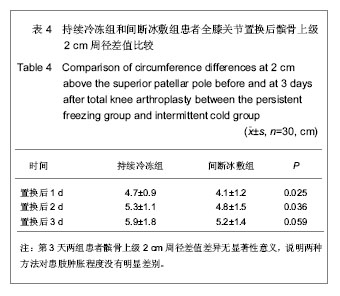| [1] McHugh GA, Luker KA, Campbell M, et al.Pain, gpysical functioning and quality of individuals awaiting total joint replacement:a longitudinal study.J Eval Clin Pract.14:19-26.
[2] Brander V, Gondek S, Martin E, et al. Pain and depression influence outcome 5 years after knee replacement surgery. Clin Orthop Relat Res.2007;464 :21- 26.
[3] 陈孝平.外科学[M].北京:人民卫生出版社,2004:922.
[4] Schaser KD,Disch AC,Stover JF,et al.Prolonged superficial local cryotherapy attenuates microcirculatory impairment regional inflammation and muscle necrosis after closed soft tissue injury rats.J Sports Med.2007;35(1): 93-102.
[5] Meeusen R,van der veen P, Harley S.Cold compression in the treatment of athletic injuries.Am J Med Sports.2001; 3(3): 166-170.
[6] Merrick MA, Rankin JM, Andres FA, et al. A prel iminary examination ofcryotherapy and secondary injury in skeletal mus cle. Med Sci Sports Exerc 1999;31(11):1516-1521
[7] Enwemeka CS, Al len C, Avi la P, et al. Soft tis sue thermodynamics before, during, and after cold pack therapy. Med Sci Sports Exerc.2002;34(1):45-50.
[8] Schroder D, Passler HH. Combinat i on of cold and compression aft erknee surgery: a prospect-ive randomized s tudy. Knee Surg, Sports Traumat ol, Arth roscopy.1994; 2(3): 158.
[9] Healy WL,Seidman J, Pfeifer BA,et al.Cold compression dressing after total knee arthroplasty.Clin Orthop.1994;299: 143-146.
[10] McDowell JH,McFarland EG,Nalli BJ.Use of cryotherapy for orthopedic patients.Orthop Nurs.1994;13(5):21-30.
[11] 李小寒,尚少梅.基础护理学[M].北京:人民卫生出版社,2006:182.
[12] 黄群英,谢燕崧,刘素霞,等.加压冷疗在初始膝关节置换术后的应用[J].中华关节外科杂志:电子版,2013,7(3):90-91.
[13] 仇雄文,肖榕. 改良冰敷方法在人工膝关节置换术后患者中的应用[J].齐鲁护理杂志,2013,19(2): 42-43.
[14] 陆卉.冷敷在全膝关节置换术后应用的研究进展[J].全科护理, 2012,10(28):2661-2662.
[15] 鲁钧,张泉民,王跃平.人工全膝关节置换术出血量控制策略[J]. 中国保健营养,2012,22(20): 4679-4679.
[16] 乔艳琴,蒋攀峰. 持续冰敷对全膝关节置换术后24h出血量的影响[J].中国现代药物应用,2012,6(12):59-60.
[17] 王晓庆.全膝关节置换术后自制冷敷冰袋的制作与应用[J]. 齐鲁护理杂志,2012,18(14): 117-117.
[18] 王春萍,田琴,李英.10%盐水冰袋联合弹力绷带持续加压冷敷用于全膝关节置换术后关节肿痛[J].护理学杂志,2012,27(8): 16-17.
[19] 蒋涛,瞿玉兴,许建安.关节镜治疗膝关节盘状半月板损伤的临床疗效及术后疼痛的危险因素分析[J].中国全科医学,2012,15(11): 1278-1280.
[20] 谢燕崧,陈艺,宁军. 10%盐水冰袋持续冷敷减少膝关节置换术后出血的应用[J].中华关节外科杂志:电子版,2011,5(6):791-793.
[21] 詹学华.人工全膝关节置换术后膝周冰袋冷敷对隐性失血的影响分析[J].中国中医骨伤科杂志,2011,19(8): 38-39.
[22] 李健. 冷敷介入膝关节置换术20例临床观察[J].吉林医学,2011, 32(9):1810.
[23] 张国妹,姚剑英,周玉娟,等.生物冰袋冷敷在全膝关节置换术护理中的应用[J].广东医学,2011,32(19):2616-2617.
[24] 饶世鸣,蒋乐佩,郑文娴,等.持续性生物冰袋冷敷在全膝关节置换术后减轻关节肿痛的研究[J].现代实用医学,2010,22(7):821- 822.
[25] 姜会枝,刘便,刘海静.高渗盐水混合物间断冷敷在人工全膝关节置换术后的应用研究[J].护理研究,2010,24(21):1929-1930.
[26] 尹志改.自冷式冰袋冷敷减轻膝关节置换术后关节肿痛的研究[J].实用骨科杂志,2010,16(2):146-148.
[27] 卿忠,刘淼.全膝关节置换术出血量分析及控制出血对策[J].中国骨与关节损伤杂志,2008,23(3): 232-233.
[28] 李军,卢雪玲,付桂莲.冰敷在人工全膝关节置换术后减少出血的体会[J].菏泽医学专科学校学报,2007,19(4):37-38.
[29] 尹志改.10%盐水冰袋冷敷减轻膝关节置换术后关节肿痛的研究[J].护士进修杂志,2007,22(17):1550-1552.
[30] 刘爱玲,丁艳玲,郑建红,等.冷敷对人工膝关节置换术后康复训练效果的影响[J].山东医药,2007,47(14):84.
[31] 田明祥,王鑫,荆鑫,等.自制冷敷加压装置在人工全膝关节置换术中的作用[J].中国临床康复,2003,7(32):4420-4420.
[32] Kullenberg B, Ylipea S,Soderlund K,et al.Postoperative cryotherapy after total knee arthroplasty:a prospective study of 86 patients.J Arthroplasty.2006;21(8):1175-1179.
[33] Schroder D, Passler HH. Combinat i on of cold and compression aft erknee surgery: a prospect -ive randomized s tudy. Knee Surg, Sports Traumat ol, Arth roscopy. 1994;2 ( 3) : 158.
[34] 马丽红,张玲,吴秋霞.冷疗机持续冷敷在膝关节置换术后的应用研究[J].护理研究,2012,26(10):2739-2741.
[35] Adie S, Naylor JM, Harris IA.Cryotherapy after total knee arthroplasty a systematic review and meta-analysis of randomized controlled trials. J Arthroplasty. 2010;25(5): 709-715. |




